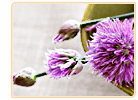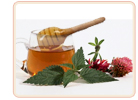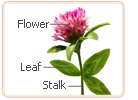What is Red Clover?
 Red clover is a seasonal clover plant that originates from Asia, parts of Northern Africa, and Central Europe. Its high mineral and vitamin content is used to boost human cell regeneration and strength, which are key to fighting off illness. Red clover is also used to ease some menopausal symptoms, such as hot flashes and night sweats. Due to its extensive health benefits, red clover has been purposefully grown and naturalized in other parts of the world. Red clover is a seasonal clover plant that originates from Asia, parts of Northern Africa, and Central Europe. Its high mineral and vitamin content is used to boost human cell regeneration and strength, which are key to fighting off illness. Red clover is also used to ease some menopausal symptoms, such as hot flashes and night sweats. Due to its extensive health benefits, red clover has been purposefully grown and naturalized in other parts of the world.
The red clover flower grows from its trademark three-leafed roots and is easily identifiable due to its vibrant shades of light pink and red.
Each flower contains high levels of isoflavones, which are capable of lessening the harshness of menopausal symptoms.
Despite not being an exact science, red clover has been used for centuries and its history is explained in more detail below.
Background and History of Red Clover
In ancient times, the Greeks, Celts, and Romans considered red clover a magical plant that could ward off evil. People considered clovers with four leaves particularly lucky.
While such beliefs are mostly disregarded today, it is clear that red clover is an extremely beneficial plant in many ways. These include:
. Medicinally: For curbing menopausal effects in women
. Gastronomically: The sprouts from red clover seeds are often used in cooking
. Agriculturally: Farmers plant red clover because it takes nitrogen from the air and deposits its benefits into the soil.
Different Names of Red Clover (Synonyms - Etymology)
In Germanic, the sound complex of the word is derived from the term 'sticky pap'. The name red clover seems to come from its sticky nectar, which is used to make honey.
Different names for red clover include:

. Trifolium pretense
. Beebread
. Cow clover
. Purple clover
. Missouri milk vetch
. Trefoil
. Meadow clover
How Does Red Clover Grow?
Red clover seeds grow best in moist but well-drained soil but they can still flourish in poorly-drained soil. The red clover seed also needs a lot of sunlight to grow. Such sunlight and soil conditions are easily met and this is why the red clover plant can be found growing wild on roadsides and in ditches.
 Red clover seeds grow best in moist but well-drained soil but they can still flourish in poorly-drained soil. The red clover seed also needs a lot of sunlight to grow. Such sunlight and soil conditions are easily met and this is why the red clover plant can be found growing wild on roadsides and in ditches. Red clover seeds grow best in moist but well-drained soil but they can still flourish in poorly-drained soil. The red clover seed also needs a lot of sunlight to grow. Such sunlight and soil conditions are easily met and this is why the red clover plant can be found growing wild on roadsides and in ditches.
Red Clover is known as "cow fodder" because it can be used as food for grazing animals . It isn't useful as groundcover because, as a biennial plant, it only lasts for two years. The red clover seed typically sprouts from May to December.
What Does Red Clover Look Like?
 Red clover can be identified by its pink and red flowers, which blossom from its large, v-shaped leaves. Its leaves form in clusters of three and range from 8-15 mm wide to 15-30mm long. Red clover can be identified by its pink and red flowers, which blossom from its large, v-shaped leaves. Its leaves form in clusters of three and range from 8-15 mm wide to 15-30mm long.
Red clover seeds range from two to three millimeters long and an adult clover plant can achieve a height of up to three feet tall.
The mild flavor and crunch of the red clover seed makes it a subtle but tasty addition to salads and other dishes. Its seeds normally take five to six days to sprout and have a shelf-life of up to six weeks.
Now that red clover has been explained, continue to the next section to find out how red clover works.
Conclusions about Red Clover
Red clover is great for treating some menopause symptoms, but as a phyto-estrogenic herb it can cause a number of harmful side effects. Furthermore, red clover has been criticized because it can interfere with the treatment of breast cancer.
Other alternative treatments are just as effective as red clover, but without the side effects. Non-estrogenic herbs, for example, are a great option for treating menopause symptoms. Read more in the following article.
Which herb should women try? Today women are looking for relief from their menopause symptoms with herbs. Phytoestrogenic herbs and non-estrogenic herbs are good in relieving menopause symptoms, but recent studies show that non-estrogenic herbs have no side effects because they help the body to produce its own hormones instead of introducing hormones like the phytoestrogenic ones. Learn more about non-estrogenic herbs for menopause.
| 

